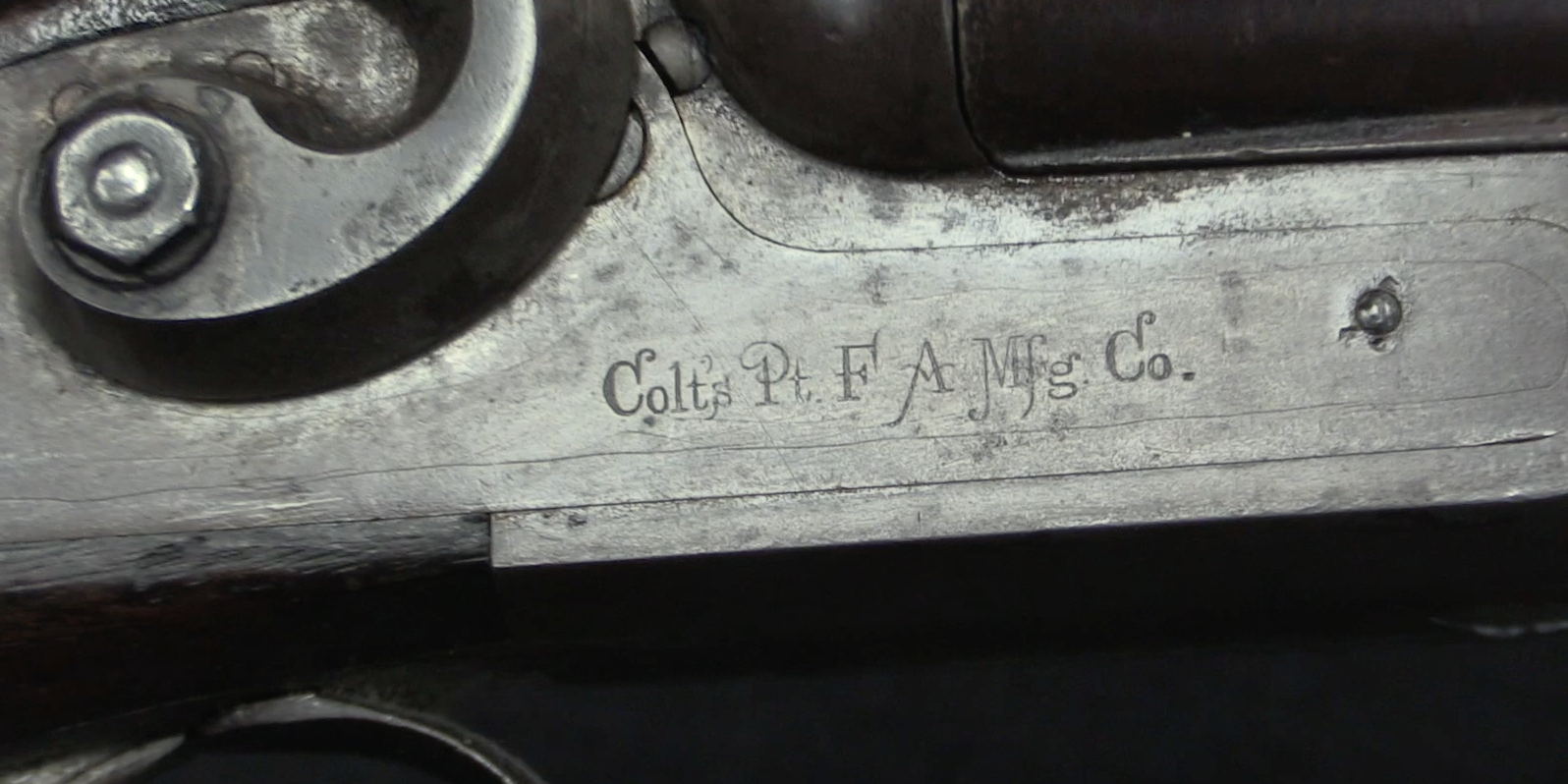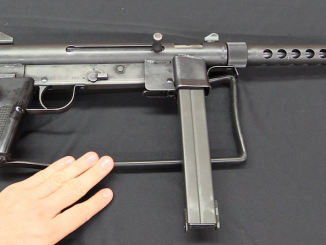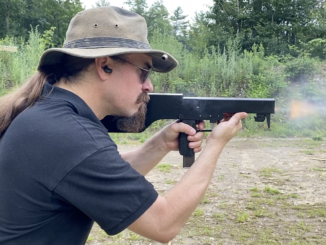The Winchester G30R is the final iteration of David Marshall Williams’ work on a full power .30 caliber military rifle. The project began with a design by Ed Browning (John Browning’s half brother) using a tilting bolt an annular gas piston, manufactured for US military trials by Colt. It moved to the Winchester company, which assigned Williams to the project when Browning died in 1939. Williams first replaced the annular gas piston with his gas tappet system, creating the G30M rifle. This performed poorly in trials, and the next iteration was the replacement of the tilting bolt with a Garand-type rotating bolt, creating the Winchester M2 rifle.
The US military was not interested in the M2 in .30-06, but thought the concept could be ideal for the Light Rifle trials then underway, and Winchester scaled it down to .30 carbine, and won the Light Rifle trials with it. That weapon would go on to become the M1 Carbine. Once it was in mass production, Winchester returned to the M2 design and improved it into this G30R. It was tested by the Marine Corps, but not adopted. The Canadian military also expressed an interest, but the US government opted to not allow any exports, and so Canada never tested it.
The US Army was quite satisfied with the M1 Garand, but suggested that this rifle might be made into a replacement for the BAR if it were redesigned a bit for greater sustained fire capacity. Winchester did so, creating the Winchester Automatic Rifle (WAR), which was on track for adoption until World War Two ended and immediate arms development became a much less important priority for the military.
Thanks to the Institute of Military Technology for allowing me to have access to this rifle so I can bring it to you!




” It was tested by the Marine Corps, but not adopted. The Canadian military also expressed an interest, but the US government opted to not allow any exports, and so Canada never tested it.”
This seems like the dog in the manger.
What were reasons to not allowing exports?
If it was tested in U.S. and found not good enough to adoption why not to let ally test it?
It is quite peculiar decision considering that various AFV and aeroplanes were exported to Canada in that time: https://en.wikipedia.org/wiki/List_of_military_equipment_of_the_Canadian_Army_during_the_Second_World_War
For your information, experimental weapons generally tend not to be exported, especially if a batch of prototypes risk a mysterious disappearance en route to the intended recipient. Or perhaps Canada was told to get its guns from England. And exported vehicles tend to use weapons already accepted into service. I could be wrong.
“experimental weapons generally tend not to be exported”
By 1940s self-loading rifle was not game-changer, it would be understandable if it would weapon which would tremendous change balance in favor of user.
Maybe not “tremendous change”, but if this rifle was better than the Garand, then it might be a factor in the decision not to export.
I was going to mention it too. There was lots of American originated war materiel made in Canada, among it trucks and tires, lots of them. There were so many tires left in warehouses after the war that whole new enterprise started based on it surviving (and even thriving) to this day under name Canadian Tire.
I suspect the reason the rifle was not allowed to be exported to Canada was that at the time US companies had to fill US orders first before being allowed to pursue export contracts.
The Wikipedia list you linked doesn’t say how many of those US weapons were actually purchased by Canada, or under what circumstances, so in itself doesn’t tell us much. Canada also exported war material to the US by the way, so there was two-way trade going on.
As for how the Canadian interest arose, I don’t have any information but I would not be surprised if the Winchester salesmen showed up in Ottawa with a handful of brochures and persuaded Canada to evaluate it. Arms sales is a business, and if sales efforts in the US weren’t going well they would look abroad for possible customers.
I very much doubt however that Canada would have been seriously interested in adopting the Winchester rifle in significant quantities. Lee Enfield production was under way at Long Branch (Toronto), and switching to a completely different rifle mid war was unlikely.
My on-fly observation: this is indeed more visibly advanced than Garand; especially the short built-in length for operating system. The workmanship is impeccable. I am less enthused about massive chunk of operating handle containing cam, but all-in-all this is really good looking rifle.
As for possible Canadian export version, I suppose it would be chambered in .303 British. Strange that Winchester did not get the nod to proceed with commercial venture into next-door friendly country.
In the case a G30R went to Canada and was mass produced for British ammunition, plenty of work would be required to get the rifle to fire and cycle a rimmed cartridge without jamming. The Bren is a good case of converting rimless to rimmed and from metric to imperial units. There were plenty of teething issues like significant figures and cartridge powder chemistry. And rim-lock for .303 (and 7.62x54R) is a particularly nasty problem if loading is done wrong. And then we would have to deal with licensing issues (intellectual property law again), to say nothing about potential interruptions of the logistics chain (convincing the guys to add more product support/troubleshooting teams in the event of massive floods of user complaint letters after having the producers buy up American tooling or spend money creating new tooling for the new gun).
““Carbine” Williams”
Overview of his work, including patent numbers: http://www.uscarbinecal30.com/Williams5.html
Ok it came after the Garand, but way ahead of the M14. Why wasn’t it adopted instead of the M14?
Politics in the office, my friend. And the army did not wish to dramatically alter tooling for a new weapon! “Why bother inventing a new weapon when we can simply modify a successful product for the purpose?”
The M14 was the end result of an in-house Army Ordnance project at “improving” the Garand that went back to 1943. Like most such establishments, Ord was adamant that no “trade pattern” weapon would be adopted (requiring royalties) if a workable alternative could be concocted on the premises.
Please note that the M-14 was adopted over the H&R-made “T-48” rifle, which was the FN FAL made on the ‘inch’ system like the British version.
The whole gory story, from box-magazine M1s in .30-06 to the final product, can be found in the United States section of the 10th edition of Small Arms of the World. Including the little-known M15, a heavy-barrel version of M14 intended as a BAR replacement.
No, it didn’t work very well.
cheers
eon
Agreed. Adopting the Winchester design would have required paying LOTS of money in licensing fees. Do recall that the government is NOT exempt from intellectual property law and must give credit where it’s due.
Round and round it goes.Why not beef up the .30 carbine cartridge a bit and give it a pointed bullet?Than a slightly heavier M2 carbine version would be a real nice “assault rifle”.Hindsightt is always 20/20…
…Because we had 12 million men under arms in 1945 and only 3 million in 1946. Then it dropped to 1 1/2 million until Korea.
…..We were sitting on 6 million carbines in inventory. No need for any more. Besides, the Atomic bomb had made ground combat oppsolete and the money was going into Air Force rocketry.
…Or so they thought.
Small-bore, high-velocity rounds for military and other uses go back well over a century. The 6mm Lee Navy is the best-known example, but there was also the 5.6 x 33 Rook & Tesching;
In most respects, the 5.6 x 33mm rimless falls neatly between the 5.7 Johnson Spitfire (5.7 x 33mm) of 1961 and the modern 5.7 x 28 FN P-90/ FiveSeven round. The length of the Johnson round but with a case head closer to the FN cartridge dimensions.
Its power limitations were due to being loaded with a round-nosed bullet in front of the smokeless powders of the turn of the 20th Century. Loaded with a spire-pointed bullet and more modern powders, it would probably have come close to the performance of the .221 Remington Fireball.
Actually, the .221 Fireball would make a pretty decent combat rifle round itself, even today.
clear ether
eon
“.221 Fireball”
This cartridge is said to be inspiration for cartridge for SCAMP:
http://modernfirearms.net/en/submachine-guns/u-s-a-submachine-guns/colt-scamp-eng/
“.221 Fireball would make a pretty decent combat rifle round itself”
It probably would be possibly to use it in magazine-in-grip fashion similar to
http://modernfirearms.net/en/assault-rifles/sweden-assault-rifles/interdynamics-mks-eng/
somewhat less unwieldy than in 5,56×45 cartridge case
The length of the fireball suggests a close kinship with the .22 wife and hornet.
The .222 .221 etc headsize is very close to the size of the hornet rim.
Damn that autocorrect
That was my thought many times in past.
Answer is in the wind 🙂
“pointed bullet”
Assuming that it mean Spitzer.
There exist 5.7mm Johnson cartridge:
https://en.wikipedia.org/wiki/.22_Spitfire
which is .30 Carbine necked down to .22 caliber
can be used in M1 Carbine after changing barrel
Gosh… T…G30R in, say, 7mm/.276 Pedersen, anyone? I mean, here it is, and the U.S. won WWII, so all we need is to tinker with the T20 M1-garand-with-BAR-magazines-’cause-Coronet/Olympic/Downfall… Every GI who survives to make it inland will have a lighter BAR, and at night some foxholes will have M3 carbines with huge infrared night-sights to stave off night infiltration…
So instead of the M14 as a knock-off of the M1 Garand and using the same Garand developed tooling, what of going back to a pre-MacArthur period? “Well, but for Douglas “American Caesar” MacArthur there was almost a .276-cal. Garand rifle with a ten shot en-bloc magazine…” Now that the war is won, how about returning to the issue of a 7mm cartridge and a rifle that combines the merits of the Garand design with a few new-fangled ideas based on an appraisal of its faults…? And a more honest competition with the British EM-2 .280/30 7x44mm cartridge even if, ultimately, it was found necessary to retain a more powerful cartridge for some kind of GPMG? More wrinkles to the “lost opportunities” chapters…
Ian,
The North Carolina Museum of History has a G30R in their Williams Exhibit in addition to several extra barrels. There’s no s/n on the receiver. Only number is 17 on the safety. I was able to get a few photos of it inclusing with the handguard removed but had to use the ceiling lights in the exhibit area instead of using their photo studio.